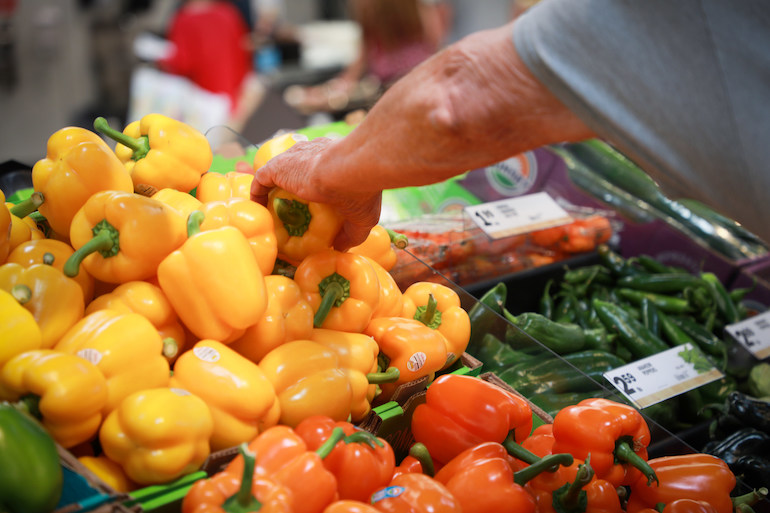The grocery industry has jumped in with broad support of the Biden administration’s $8 billion plan to tackle food insecurity and improve nutrition and wellness nationwide.
Announced yesterday, the five-pronged National Strategy on Hunger, Nutrition and Health includes expanding food access and affordability, integrating nutrition and health, empowering all consumers to make more informed and healthier food choices, enhancing nutrition and food security research, and enabling physical activity for all. The effort responds to this past summer’s “Call to Action for White House Conference on Hunger, Nutrition and Health,” in which the administration said it aims to end hunger and reduce diet-related disease by 2030, while also eliminating disparities among the most-impacted communities.
Of the more than $8 billion in private- and public-sector commitments, at least $2.5 billion will be invested in startup companies developing solutions to hunger and food insecurity and over $4 billion will be earmarked toward philanthropy that widens access to nutritious food, promotes healthy food selections and raises Americans’ physical activity, the White House said.
In the plan, the administration noted that one in 10 households experienced food insecurity last year, with almost 4% of those households having “very low food security,” meaning they were regularly skipping meals or reducing their intake because they couldn’t afford more food. In terms of diet-related diseases,19 states and two territories have an obesity prevalence at or above 35%, more than double the number of states in 2018, and one in 10 Americans have diabetes. One in three people will have cancer in their lifetime, and more than four in 10 Americans have hypertension.
What’s more, the report said, the hunger and diet-related disease isn’t distributed equally, disproportionately impacting communities of color, people living in rural areas and/or in territories, people with disabilities, older adults, LGBTQI+ people, military families and veterans.
“These are ambitious goals that I know we can do if we work together. I really do know we can do this: end hunger in this country by the year 2030 and lower the toll that diet-related diseases take on too many Americans. This goal is within our reach,” Biden said at the White House conference on Tuesday, the nation’s first summit in over 50 years addressing hunger, nutrition and health.
 “Grocery stores serve as accessible, convenient, community-based destinations for feeding assistance, preventive care, nutrition guidance, and nourishing, practical meal solutions.” Leslie Sarasin, FMI-The Food Industry Association president and CEO (Photo courtesy of FMI)
“Grocery stores serve as accessible, convenient, community-based destinations for feeding assistance, preventive care, nutrition guidance, and nourishing, practical meal solutions.” Leslie Sarasin, FMI-The Food Industry Association president and CEO (Photo courtesy of FMI)
Specific efforts in the National Strategy on Hunger, Nutrition and Health include a pathway to free healthy school meals for all; expanding electronic benefits transfer (EBT) and Supplemental Nutrition Assistance Program (SNAP) eligibility; broadening access to health assistance programs such as SNAP, the Women, Infants and Children Nutrition Program (WIC) and Medicaid; making the SNAP online grocery shopping program permanent and adding more grocery retailers and states; improving transportation options to and from grocery stores; increasing historically underserved communities’ access to affordable and healthy foods (including the elimination of food deserts) and reducing food waste.
On the nutrition and wellness side, objectives include expand Medicare and Medicaid beneficiaries’ access to “food is medicine” interventions; developing a front-of-package (FOP) labeling system for simpler communication of nutrition information; making nutrition information more easily available when grocery shopping online; expanding incentives for fruits and vegetables in SNAP; lowering sodium content and added sugars in foods; and cracking down on the marketing of unhealthy foods and beverages.
Following up Biden’s remarks, the Food and Drug Administration on Wednesday proposed updated criteria for when foods can be labeled with the nutrient content claim “healthy” on their packaging. The FDA said Wednesday that the proposed rule — a component of the National Strategy on Hunger, Nutrition and Health — would link the definition of the “healthy” claim more closely with current nutrition science, the updated Nutrition Facts label and the current Dietary Guidelines for Americans.
 “Independent grocers and wholesalers serve as the cornerstone of their communities, providing access to nutritious food, essential services, and creating jobs.” — Greg Ferrara, National Grocers Association president and CEO (Photo courtesy of NGA)
“Independent grocers and wholesalers serve as the cornerstone of their communities, providing access to nutritious food, essential services, and creating jobs.” — Greg Ferrara, National Grocers Association president and CEO (Photo courtesy of NGA)
“Nutrition is key to improving our nation’s health,” Xavier Becerra, secretary of the Department of Health and Human Services, said in a statement. “Healthy food can lower our risk for chronic disease. But too many people may not know what constitutes healthy food. FDA’s move will help educate more Americans to improve health outcomes, tackle health disparities and save lives.”
More than 80% of people in the U.S. aren’t eating enough vegetables, fruit and dairy, and most people eat too much added sugar, saturated fat and sodium, the FDA reported. Under the proposed rule, to be labeled with the “healthy” claim on food packaging, products would need to contain a certain meaningful amount of food from at least one of the food groups or subgroups (fruit, vegetable, dairy, etc.), as recommended by the Dietary Guidelines, and adhere to specific limits for certain nutrients, such as saturated fat, sodium and added sugars. The threshold for the limits is based on a percentage of the Daily Value for the nutrient and varies depending on the food and food group.
“Diet-related chronic diseases, such as cardiovascular disease and type 2 diabetes, are the leading causes of death and disability in the U.S. and disproportionately impact racial and ethnic minority groups,” stated FDA Commissioner Robert Califf. “Today’s action is an important step toward accomplishing a number of nutrition-related priorities, which include empowering consumers with information to choose healthier diets and establishing healthy eating habits early. It can also result in a healthier food supply.”
FMI-The Food Industry Association noted Wednesday that its efforts to stop hunger, improve nutrition and cut diet-related disease align closely with the White House strategy. FMI’s commitments include donating more than 2 billion meals in 2023, expanding food access to underserved communities, leveraging federal feeding and food-as-medicine programs, and driving consumer education and transparency, with the latter involving an FMI member commitment to 100 million impressions/consumers starting in 2023.
“The food industry has a critical role to play in addressing hunger and helping to improve the nutrition and health of all Americans. Grocery stores serve as accessible, convenient, community-based destinations for feeding assistance, preventive care, nutrition guidance, and nourishing, practical meal solutions,” FMI President and CEO Leslie Sarasin commented. “It will take all of us working together to achieve these goals. I have full confidence in the food industry’s spirit of innovation and collaboration to not only reach these goals, but far exceed them. We look forward to continuing to work with the White House, members of Congress, our industry partners and other stakeholders to ensure all Americans have access to healthy, nourishing foods.”

As part of its efforts to battle food insecurity, Albertsons Cos. plans to expand the availability of its ReadyMeals from 600 to 1,100 stores by the end of the fiscal year.
Over the next two years, the National Grocers Association (NGA) said it will assist with improving access to independent grocery stores by working to increase the number of retailers authorized for SNAP online purchases, with a focus on rural communities and areas with low food access. NGA also aims to create a toolkit with a list of resources and funding opportunities to support the expansion of full-service grocery stores in designated food deserts.
“Across the nation, independent grocers and wholesalers serve as the cornerstone of their communities, providing access to nutritious food, essential services, and creating jobs,” according to Greg Ferrara, NGA president and CEO. “As the supermarket industry continues to evolve and innovate, NGA and our members are committed to preserving the longstanding, strong public-private partnerships with federal and state nutrition programs, and enhancing capabilities to reach and serve all Americans.”
Other industry efforts in line with the National Strategy on Hunger, Nutrition and Health include the following:
• Albertsons Cos. said it plans to donate over 100 million meals in 2023 and 1 billion meals by 2030, help 50,000 eligible neighbors enroll in SNAP and WIC benefits in 2023, provide 50 million evidence-based nutrition recommendations to digital customers by 2024 and launch six health campaigns by 2025 via in-store events and digital platforms. The grocery retailer also has committed to give 100 million customers access to recipe and meal planning tools by 2025, introduce 1,000 new nutritious and approachable recipes, and expand the availability of its ReadyMeals from 600 to 1,100 stores by the end of the fiscal year.
“Albertsons Cos. is a grocery hub for thousands of communities, providing access to food, medications and care. These initiatives further highlight our commitment to building a deeper connection between food and well-being,” Omer Gajial, chief digital officer and executive vice president of health at Albertsons, said in a statement. “As a company, we continue to challenge ourselves to provide simple, actionable solutions, helping our customers and communities to meet their nutritional needs and health goals.”
• Hy-Vee Chairman and CEO Randy Edeker announced Wednesday that the Midwestern grocer will deliver 30 million meals to vulnerable communities by 2025 and deploy its team of registered dietitians to educate 100,000 Americans in areas of low food access on healthy eating and nutrition by 2026.
“During these challenging economic times, we know more families are turning to food banks and community resources for assistance, and that’s where we can help,” Edeker noted. “By providing 30 million meals by 2025 and providing health and nutrition education to 100,000 Americans by 2026, we can better the lives of those families who are currently food insecure. Our ultimate goal is to help eliminate hunger and connect with those in need, because no one should ever have to worry about where their next meal will come from.”

Meijer announced a rolling set of automatic discounts, from $5 to $10 (5% to 10%), on SNAP recipients’ purchases of qualifying fruits and vegetables.
• Instacart today unveiled Instacart Health, described as a major new health and nutrition initiative encompassing new products, partnerships and services to bolster food access and tie nutrition more closey with health care. Efforts include working with the U.S. Department of Agriculture to incorporate the SNAP and Temporary Assistance for Needy Families (TANF) programs into its online platform, with a goal to extend these benefits to its 650-plus grocery partners by 2030. On its platform, Instacart also aims to launch 23 new diet-specific tags plus a new feature that enables health care providers, caregivers and nutritionists to create shoppable lists for disease-specific diets. A new stipend technology, Fresh Funds, also allows any organization to allocate funds to employees and patients to buy fresh, nutritious foods on Instacart’s platform.
• In 2023, Target’s Shipt same-day delivery arm plans to launch an accelerator to improve access to capital and technical assistance for local retailers seeking e-commerce capabilities, at least half of which will be in the food, beverage and grocery categories. Also next year, Shipt aims to roll out two new product features that facilitate healthy food selection for diet-specific meal planning and enable the acceptance of SNAP EBT benefits to all eligible retailers on its platform.
• Publix Super Markets has committed to donate $3.85 million to 22 Feeding America food banks to set up free, mobile food pantries for stocking local fruits and vegetables, with the Southeastern grocer supplying pantries with at least 500,000 pounds each of produce in their first year of operation. In 2023, Publix also plans to host a national hunger summit with Feeding America food bank partners as well as run its Feeding More Together register campaign, expected to generate up to $10 million in in-kind donations.
• Meijer said Wednesday that it will offer a rolling set of automatic dollar-off and percentage-off discounts, from $5 to $10 and 5% to 10%, respectively, on SNAP purchases of qualifying fruits and vegetables. The supercenter chain, too, will provide coupons to SNAP customers to take similar discounts off future purchases of fresh produce. The 2018 Farm Bill allows SNAP-authorized stores like Meijer to seek a USDA waiver to provide SNAP participants incentives for selecting healthier food items, such as fruit, vegetables, low-fat dairy and whole grains. Starting this fall, Meijer plans to offering this incentive at all 499 of its SNAP-authorized stores.
Meijer President and CEO Rick Keyes commented, “We are participating in this important federal initiative to help families get easier access to healthy foods, which is another way we can help reduce food insecurity.”
• Walgreens has pledged a 20% boost in the fresh food selection at its stores by 2030, led by a wider variety of fresh produce and other healthy choices, complementing the current assortment of dairy and shelf-stable packaged fruit and meat. The drug chain said it will team with local distributors and prioritize underserved communities, as well as launch new solutions to highlight healthy ingredients and reduce harmful ones.
• DoorDash plans to partner with community organization in 18 cities in 13 states to alleviate transportation barriers to healthy food access. To that end, the food delivery company will provide targeted support via $1 million in DoorDash Community Credits; access to Project DASH on the DoorDash logistics platform; and funding of in-kind charitable food deliveries through its platform.


